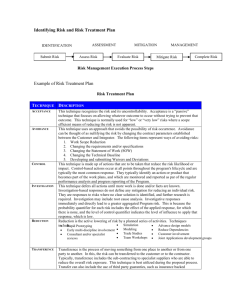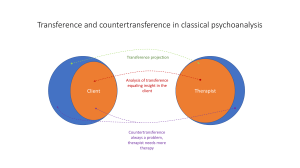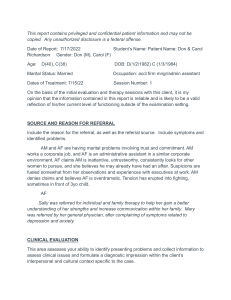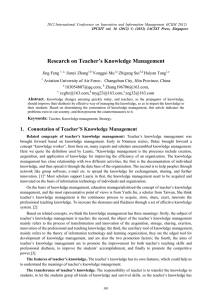Dr. Frank Yeomans - Borderline Personality Disorder
advertisement
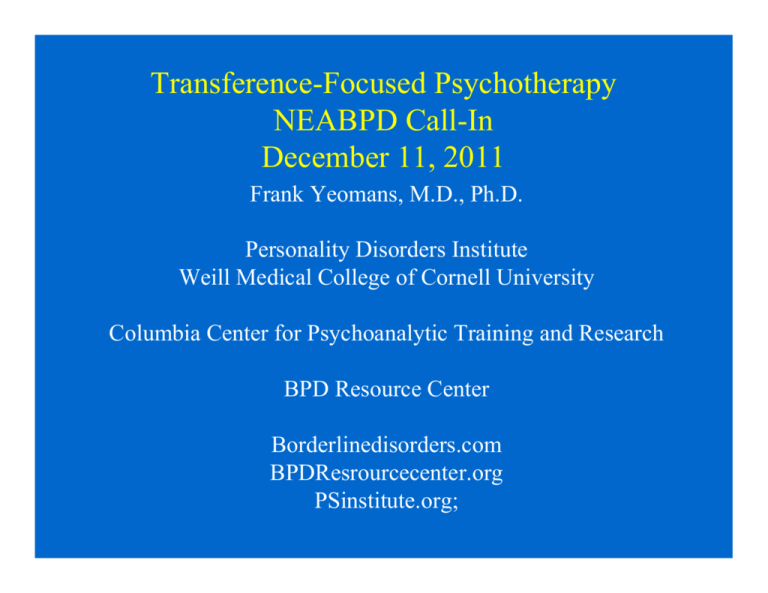
Transference-Focused Psychotherapy NEABPD Call-In December 11, 2011 Frank Yeomans, M.D., Ph.D. Personality Disorders Institute Weill Medical College of Cornell University Columbia Center for Psychoanalytic Training and Research BPD Resource Center Borderlinedisorders.com BPDResrourcecenter.org PSinstitute.org; Describing TFP - 1 Indications / Disorders treated • BPD and other severe personality disorders Frame of Reference and Conceptualization of disorder • Psychodynamic Object Relations Theory What Changes and how • Going from a fragmented to a coherent sense of self though reflection of the experience of self and other in the here-and-now Describing TFP - 2 Treatment Frame • 2x weekly, individual, frame set up in treatment contract – possible adjunctive treatments Therapist Stance • “Neutral” with concern and periodic deviations, active Treatment Technique • Setting a safe frame, containing and increasing awareness of intense affects, interpreting contradictory self states and views of others To simplify: our focus is Identity and Difficulty “reading” Self and Others • Sense of self and others is fragmented, distorted and superficial • Difficulty “reading” others… and self • Lack of continuity of experience • Feelings of emptiness • The vicious circle of temperamental predisposition to emotional dysregulation and distortions in perception Change • Identity consolidation • More adaptive defenses (ways of managing stress and internal conflict) • Increased modulation of emotions • Better adaptation to the challenges of work and love Theoretical Underpinnings of TFP: Object Relations Theory Self Affects Other The Object Relations Dyad Dyads as Building Blocks • These internalized relationship patterns modified by fantasies and defenses • The dyad exists within the individual and it’s basic impact is on self relating to self, although it regularly gets played between self and others. The classic Abuser-Victim or Abandoner-Abandonee dyads • Dyads of similar affective charge aggregate Split Organization: Consciousness of all-good or all-bad Normal Organization: Consciousness of Integration/complexity The Evolution of Treatment From Splitting to Integration; From the projection of negative motivations to the capacity to take responsibility for one’s thoughts, feelings, actions and integrate them. (In older psychoanalytic terminology, to move from the Paranoid-schizoid position to the Depressive position) ----------------------------------------- How does focusing on the transference facilitate this change? Transference • The activation of internal object relations in the relationship with the therapist. • An affect is the manifestation of an underlying imaged relationship • Working with object relations that are activated in the immediate moment creates a therapy that is “experience-near” – the affect and the opportunity to reflect on it are present simultaneously Working with Transference • Since transference is the activation of internal object relations leads to the activation of affects and conflicts, the basic strategy is to: – to tease out these internal relationships, – to help the patient • Gain and tolerate awareness of these internal relationship representations, • Integrate them into a coherent whole, and • Generalize the experience in therapy to other relations Patient’s Internal World -S1 -a1 -O1 S = Self-Representation O = Object - Representation a = Affect Examples S1 = Meek, abused figure O1 = Harsh authority figure a 1 = Fear S2 = Childish-dependent figure O2 = Ideal, giving figure a2 = Love S3 = Powerful, controlling figure O3 = Weak, Slave-like figure a3 = Wrath +S2 . +a2 +O2 -O3 -a3 -S3 Etc. Why focus on TRANSFERENCE? (the immediate experience of self and other) • Experience of Self • …and of therapist a1 S1 S1 O1 S2 S2 a2 O2 S3 S3 a3 O3 OBJECT RELATIONSHIP INTERACTIONS: OSCILLATION Object Rep Self-Rep Fear, Suspicion, Hate Persecutor Victim Fear, Suspicion, Hate Persecutor Victim (Oscillation is usually in behavior, not in consciousness) OBJECT RELATIONSHIP INTERACTIONS: DEFENSE Fear, Suspicion, Hate Persecutor Opposites Victim Longing, Love Cared-for Child Perfect Provider Basic Techniques • Setting and maintaining the frame • The interpretive process: – Clarification of internal states – Confrontation of contradictions – Interpretation of lack integration of the self TFP - What Changes? Clinical improvement results from structural change • Increased reflection, facilitated by: – Holding function of therapist – Interpretation • Decreased splitting • Identity consolidation
